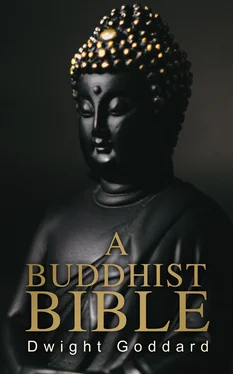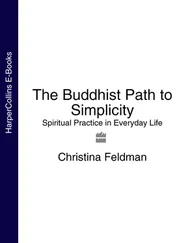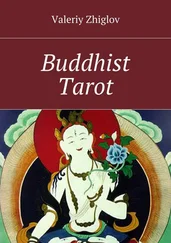This brings us to the main interest of this book, the life and Sutra of Hui-neng, the Sixth Patriarch, but before we do so it is wise to say a few words about the general character of Ch’an Buddhism as it was in his day and show how it differed from the ordinary run of Buddhism throughout China. As we have already pointed out Buddhism as generally held was of the foreign type which had been presented by Indian monks and Indian scriptures. It was largely given up to a study of the various scriptures and an easy-going practice of dhyana. It was still a foreign religion, and only slightly affected by its Chinese environment. On the contrary Ch’an Buddhism was not at all intellectual, was far from being easy-going, and had become profoundly influenced by Chinese Taoism and Chinese customs.
In closing this introductory chapter it is well to sum up the characteristics of Ch’an Buddhism as they differed from the orthodox Buddhism of that early period. Negatively, it was more atheistic. Shakyamuni had been more agnostic concerning the nature of Reality, Nestorian Christianity was emphatically theistic, while Taoism was decidedly atheistic, looking upon Tao as being Ultimate Principle rather than personality. Mahayanistic Buddhism in contact with the great theistic religions of Central Asia had grown to be more philosophic, looking upon Reality in its three phases of essence, principle, and transitory appearances as existing in a state of undifferentiated Oneness.
In contact with the polytheism of India and the animistic spiritism of Tibet it had absorbed much of their love for differentiated images and ranks of divinities; but that was for the accommodation of its more ignorant believers than for its elite. Under the influence of Taoism, Ch’anism became at first quite decidedly atheistic and iconoclastic, shading off later on into a more tolerant attitude, but even down to today, Ch’an in China and Zen in Japan make very little of their images which are used more for decoration than for worship. The deification of Shakyamuni Buddha that marked the Hinayana of Ceylon and Burma is almost entirely absent in Ch’an; in fact, the adoration shown Amitabha is much more apparent, and images of Kwan-yin, Manjushri and Kasyapa are just as frequently seen, while adoration to the image of the Founder of each particular temple and even for the Master of the Founder, seems to be more sentimentally sincere and earnest.
Further, under the influence of Taoism, Ch’an Buddhism had very little use for the Sutras that the Buddhism of those early days made so much of, the Lankavatara being the only exception. Ch’anists, intent in their strenuous practice of Dhyana, had found a more direct and immediate realisation of Reality and therein were satisfied. The same can be said of all the rest of the common paraphenalia of worship; they had no use for ritual, or public services, or prayer, or priests, or ranks of Dignity, or sentimentalism or emotionalism of any kind whatever. Every thing had to give way to the one thing of self-realisation of Oneness.
The result of this contact of Indian Buddhism with Taoism, therefore, was to develop in Ch’an a type of Buddhism that was coldly rational, experiential, positive and iconoclastic, and that led to a life of extreme simplicity, strict discipline, humility, industry, sympathy with all animate life, and to an equitable and cheerful peace of mind. At first Ch’an Buddhists had no temples of their own, nor organisations of any kind; they were either isolated individuals living a solitary life, or were groups of disciples gathered about a Master. This later developed into the calling of Ch’an Masters to be the heads of monasteries belonging to other sects, and still later to the acquiring of their own monasteries and temples, with all their vested abbots of high degree, and ceremonial ritual and worldly pride. Nevertheless, as of old, the true Ch’an monk is more often to be found in some solitary hermitage, busy and cheerful at his manual work, humble and zealous at his practice of Dhyana, intent on the one goal of self-realisation of enlightenment, Nirvana and Buddhahood.
While Bodhidharma is usually credited with being the founder of Ch’an Buddhism and rightly so, it was Hui-neng the Sixth Patriarch who gave it more definite character and permanent form that time has tested and approved. Ch’an Buddhism seems to have discerned the essentials of Shakyamuni's teachings and spirit better than any other sect, and to have developed their deeper implications more faithfully. This development came through its contact with Chinese Taoism under the lead of Bodhidharma and Hui-neng, making it a virile and wholesome influence for all nations thereafter. Hui-yuan yielded to the seduction of the Divine Name and thereby gained the credit of being the founder of the Pure Land sects with all their glamour of "salvation by faith." Chih-chi ( -597), one of China's greatest philosophic minds, grew up as an earnest Ch’an Buddhist but yielding to the lure of his profound study of the Scriptures became known as the founder of the Tien-T’ai school of philosophic Buddhism, Shen-shui, the learned Master of the very temple where Hui-neng worked as a laborer in the granary, yielded to the lure of egoism and popularity to become the founder of the passing school of "Gradual Attainment."
But Hui-neng more or less illiterate as he was said to be, had the force of personality, and insight and common-sense, to determine the essentials of the Dharma and the humble and patient zeal to work out and to apply them in the wisest way. The outstanding features of Hui-neng's Ch’an were as follows:
1. Distrust of all Scriptures and dogmatic teachings.
2. An enquiring mind and earnest search into the depths of one's own nature.
3. Humble but positive faith in the possibilities of such an enquiring search, in a sudden self-realisation of enlightenment, Nirvana and Buddahood.
4. Loyal and patient acceptance of such self-realisation in a following life of simplicity, self-restraint, industry, and sympathy with all animate life.
In arriving at these convictions Hui-neng's inherited and experiential acquaintance with Taoism was very influential. He was said to be illiterate but this could have been only relatively true of one who had mastered the Diamond Sutra and frequently discoursed to his disciples about the other great Sutras of the Mahayana. His study of the Diamond Sutra had convinced him of the truth of "Emptiness" and prepared his mind for the later truth of "Self-realisation of Mind-essence" which the Lankavatara taught him. But it was the conception of the Tao, active, limitless, inscrutably wise and benevolent, universal, eternal, ineffable, that gave depth and substance to his convictions and brought sympathy and patience with himself and with all animate life. It was the blending of all these elements in the mind and spirit of Hui-neng, the Sixth Patriarch, that through him gave Chinese Ch’an, and Japanese Zen, Buddhism their characteristic form and spirit.
Hui-neng was deeply influenced by his inherited and personal acquaintance with Taoism. In his leadership and teachings he made little of the personal Buddha and very much of Prajna in which he saw the Ultimate Principle of Tao in both its irradiant and integrating forms, as both intellection and compassion. The term he used for Ultimate Reality, and made so much of, was Mind-essence. A self-realisation of this was all the Buddha he cared about. It was Dharmakaya and Buddhahood and Nirvana and Tathata and Prajna. It was universal, undifferentiated and inscrutable, but was clouded over and hidden by karma and discriminative thought and desire and grasping. If these clouds could be driven away, and they all might be, then it would shine forth in all its pristine purity and potency. To Hui-neng, perfect enlightenment and self-realisation of Mind-essence and Buddhahood were the same thing. This perfect culmination of life would come suddenly as the result of an earnest and sincere concentration of mind on the search for it with in one's own mind, and this was the only way it could come. In his mind all scripture and all teachings were subordinate to the self-realisation attained suddenly by earnest Dhyana and Samadhi.
Читать дальше












